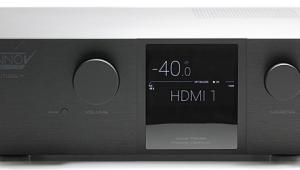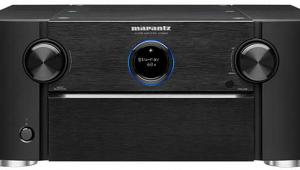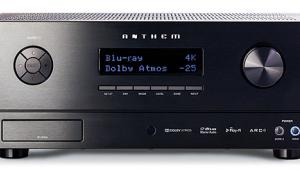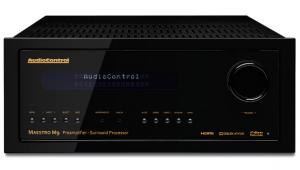Anthem AVM 40 Pre/Pro
My son, Nick, recently attended an engineering weekend for high-school seniors at a nearby university. After splitting into teams, the attendees competed in several engineering challenges, one of which was to build a contraption made from a meager assortment of supplied materials (including an Alka-Seltzer tablet) that would move a small toy car across a pan of water.

Nick's group came up with a crude but clever two-part gizmo. You wouldn't call the design elegant or efficient, but it got the job done and won the contest. The whole story got me thinking about what it takes to actually design, build, and market a product for sale to consumers—and how all three parts of the process are interrelated.
All of this brings me to the Anthem AVM 40, the middle model of three in Anthem's Audio Video Masters line of pre/pros. Anthem's pre/pros, including the $6,800 Statement D2, are perennial favorites.
The reason for this very rational exuberance around Anthem lies in the way in which all of the elements come together in these pre/pros, namely the use of extremely high-quality parts, superbly engineered circuit boards, surprisingly large power supplies, balanced analog inputs and outputs, and on and on. But the physical components are only part of the story, of course. The way in which the overall design and features are so focused on the real-world use of the products adds just as much value.
Connections Galore
The AVM 40's features, for example, are extremely well thought out but sparse. If you've had a chance to look at an AVM 40, you might be a little confused by my use of the word "sparse." After all, the AVM 40 includes four HDMI inputs, four component video inputs, and seven S-video and composite video inputs, all of which are assignable to multiple sources. Then there are 11 digital audio inputs, seven stereo analog audio inputs, one stereo balanced audio input, a six-channel audio input, 10 balanced audio inputs, and independent equalization for each source.
On the output side, there are a total of 10 balanced (XLR) and 10 single-ended (RCA) analog audio outputs, second center-channel and second subwoofer outputs, an HDMI output, as well as two component video outputs, plus an S-video and a composite video output. There are two analog A/V record outs, each outputting analog stereo audio, plus S-video and composite video. In addition, there are two independent coaxial digital audio record outs.

If you don't think that's enough, the AVM 40 is a three-zone pre/pro with component video and simultaneous S-video/composite outputs for Zone 2, along with independent S-video/composite video outputs for Zone 3. The main zone, along with Zones 2 and 3, all allow you to watch a video source while you listen to a different audio source. As a full-blooded multizone component, the AVM 40 has lots of 12-volt trigger outputs, IR receiver and emitter jacks, and RS-232 communication.
And More Features
Aside from the usual surround processing (all the Dolby and DTS modes) and other standard features, the AVM 40 possesses a few that are less common: a sweet-sounding headphone jack with independent volume/bass/treble, for example. Another feature of note is a Room Resonance Filter that you can use (judiciously) to correct a particularly awful low-frequency room mode. A Center Channel EQ provides several preset equalization curves to help center-channel speakers on top of TVs sound better. The AVM 40 also includes two of Anthem's proprietary surround modes: AnthemLogic-Music and AnthemLogic-Cinema.
So, why the sparse feature comment? Although the list of features is long, nothing is wasted, frivolous, or thrown in because it might look good on a brochure. I'll admit that, for some, the multizone capabilities might seem to be of little use; but the AVM 40 is such a high-quality piece of gear that it would be a waste not to take advantage of the capability, at least as the basis for a two-channel audio system in another room.
 May I Be Up Front With You?
May I Be Up Front With You?
Even the AVM 40's front panel is dedicated to function, not flash. The sheer number of buttons (41 in all, plus the volume control) is somewhat daunting, but what's there is logically laid out and gives the ability to easily control nearly all of the pre/pro's functions, including multizone and recording operations. Actually, if there's anywhere in which to find fault with the AVM 40, it's the front panel. The button labels are small and tough to read unless you're right up next to the unit. Unfortunately, there's no way to use a larger font without making the front panel look like a billboard, so that's a tough conundrum to fix. The small headphone graphic next to the headphone jack and volume control is a nice touch, though.
I've got another nit to pick with the front panel. Although the AVM 40 has excellent build quality overall, it had a hollow metallic ring when I pushed one of the buttons near the center of the panel. Everything still felt sturdy and well built; it simply sounded, well, cheap. That's the only small flaw I could find in an otherwise stellar product.
Sweet Performer
One of this pre/pro's distinguishing characteristics is its simple setup and operation, but that's not to say that it's simplistic. As you can imagine, with all of the assignable inputs/outputs and source-specific adjustments, the AVM 40 isn't a plug-and-play piece of gear. But it is straightforward and, for the most part, it's easy to understand how to configure the various parameters for your particular system.
None of this matters much if the pre/pro sounds like the screech of kindergarten chalk on a blackboard or sends out a picture that would make Philo Farnsworth cringe. Not to worry here because, not surprisingly, the AVM 40 is a fabulous audio and video performer. Although it doesn't have the extensive video processing and upconversion capabilities found in the AVM 50, the AVM 40 does an excellent job of transcoding S-video and component to HDMI. However, the onscreen display is only available through S-video or HDMI (480i only). Other than that, the image quality appears about the same as passing the signal straight from the source to the TV.
The AVM 40 could easily stand on its own as a high-end two-channel preamp, but that would be too sad because its performance is so exemplary with multichannel audio. In addition to being well pleased with the unit's sonic transparency with unprocessed analog audio (both two-channel and multichannel), I quickly became a fan of the company's AnthemLogic-Music processing. It very subtly but effectively took two-channel music and created a multichannel experience (sans center channel) in a way that expanded the sense of space without ruining any of the acoustic details or soundstage placement. The multilayered vocals of Anonymous 4's Love's Illusion CD, for example, became even more richly textured and open with the help of this processing.
Interestingly enough, I was surprised to find that AnthemLogic-Music made a significant difference with XM broadcasts, such as POTUS '08 (channel 130), which is brutally compressed and harsh, by taking off the harsh edge without reducing the intelligibility of the voices.
Although I didn't notice a big difference when I toggled through the individual center-channel EQs, the Room Resonance Filter came in quite handy taming a 54-hertz beast in the room. It had a huge impact (literally) whenever there was significant LFE bass in a movie, such as during X-Men: The Last Stand when Professor Xavier tries to help Phoenix get control of herself. As the room swirled around them, the sustained bass present in the scene became an integral part of the soundfield rather than the dominating element.
All This and Value, Too
It's certainly not shocking news that Anthem has come up with yet another outstanding preamp. (It would more likely be big news if they hadn't.) Yes, there are pre/pros with more features—the AVM 50 being one of them. Certainly, there are units that are more expensive, and some can eke out fractions of better performance. But with a price tag well under $4,000, HDMI switching, all the multiroom capabilities, and especially the impeccable audio and video performance, Anthem's AVM 40 has to be considered the best buy of the preamps available today.
Highlights
• Three zones with independent audio and video selection
• Multiple playback modes can be assigned to the same input
• Easy setup and operation
- Log in or register to post comments






























































